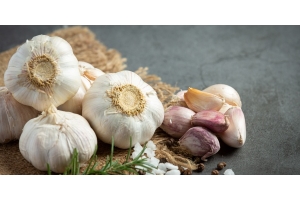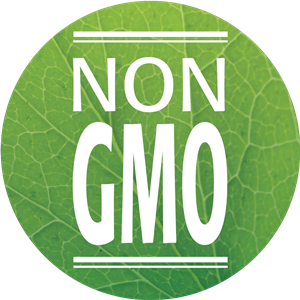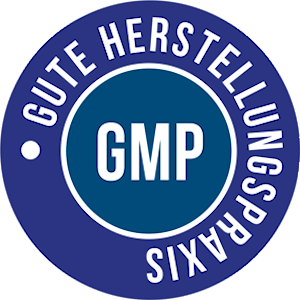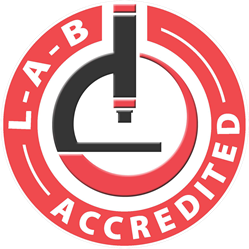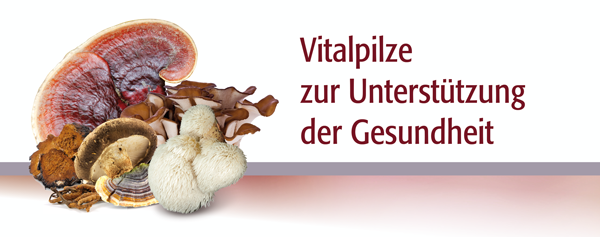

Das riesige Königreich der Pilze birgt noch immer viele Geheimnisse, da erst ca. 10% von ihnen überhaupt klassifiziert sind. Daher ist es äußerst spannend zu erfahren, wie die seit Menschengedenken postulierten positiven Wirkungen dieser faszinierenden Lebenselixiere heute mehr und mehr anhand aktueller wissenschaftlicher Methoden und Forschungsergebnisse bestätigt werden.
VitalpilzeKomplex ist eine exklusive Kombination aus den folgenden 7 hochkonzentrierten Heilpilzen (Extrakt 8:1), die synergetisch auf verschiedene Komponenten des Immunsystems wirken: Reishi, Maitake, Shiitake, Coriolus, Chaga, Cordyceps und Hericium. Unter den wirksamen Substanzen sind die Polysaccharide, genauer gesagt die Beta-Glucane, für den unschätzbaren therapeutischen Wert der Pilze verantwortlich, da durch sie u.a. die Immunantwort aktiviert wird und sie darüber hinaus auch antiumorale, antibakterielle und antivirale Wirkungen haben.(1)
Der wohl berühmteste Vitalpilz ist der Reishi, was auf japanisch „Pilz der Unsterblichkeit“ oder „Elixier des Lebens“ bedeutet. Zurückzuführen ist dieser Name auf seine allgemein anerkannte lebensverlängernde und adaptogene Wirkung, die den Organismus in die Lage versetzt, sich besser an Veränderungen und verschiedene körperliche oder geistige Stresssituationen anzupassen.(2-3)
Maitake ist ein weiterer sehr geschätzter Pilz, der sich besonders durch einen hohen Anteil an D-Fraktion auszeichnet, einer Mischung aus Proteinen und Polysacchariden, die aufgrund ihrer tumorhemmenden Wirkung bereits Gegenstand umfangreicher Untersuchungen gewesen ist.(4-6) Maitake wird außerdem für seine positive Wirkung auf das metabolische Syndrom geschätzt.(7-8) Andere Studien belegen, dass er den Blutzucker senken kann.(9)
Der Pilz Shiitake enthält einen großen Anteil an Lentinan, einem Beta-Glucan, das für seine antitumorale Wirkung verantwortlich ist(10-16). Shiitake wurde auch ausführlich im Zusammenhang mit Viruserkrankungen untersucht, wie z. B. Hepatitis B, Herpes simplex vom Typ I und II, Masern und Mumps, und zeigte gute Ergebnisse durch seine Aktivierung der T-Zellen.(17,18,19)
Coriolus, auch Schmetterlingstramete genannt, ist essentiell zur Vorbeugung und Behandlung von Virusinfektionen. Er enthält die beiden proteingebundenen Polysaccharide, die unter den Bezeichnungen PSK und PSP bekannt sind. Für PSK wurde nachgewiesen, dass es die Produktion von Immunzellen anregt.(20)
Die stark antioxidative Wirkung des Chaga ist auf die in diesem Pilz enthaltenen Triterpenoide und Steroide zurückzuführen. Desweiteren hat er entzündungshemmende,(21,22) antivirale(23-28) und krebshemmende(29-35) Eigenschaften.
Auf Immunebene besitzt der Cordyceps eine antivirale Wirkung, da er die Replikation bestimmter Viren hemmt(36-37). Außerdem hat man eine starke Schutzwirkung auf die Nieren- und Leberfunktionen beobachtet(38-40). Da er die Stoffwechselaktivität im Muskelgewebe anregt, verbessert er auch bei Sportlern die Leistungsfähigkeit(41). Und schließlich ist auch seine Wirkung bei sexuellen Funktionsstörungen erwähnenswert, da er durch seine regulierende Wirkung auf die Sexualorgane die Libido verbessert und auch bei Unfruchtbarkeit oder unregelmäßiger Menstruation Unterstützung bietet(42).
Dank seiner Inhaltsstoffe ist der Hericium bzw. Igelstachelbart eine hervorragende Unterstützung zur Regenerierung der Schleimhaut des Magens und des Zwölffingerdarms(43-44) und von hohem Wert bei allen Beschwerden im Zusammenhang mit einer erhöhten Durchlässigkeit des Darms (45), bei Gastritis, gastroösephagalischem Reflux und bei Magengeschwüren. Zusätzlich wird er als natürlicher Nährstoff für die Nervenzellen sehr geschätzt, weswegen er bei bei kognitiven Funktionsstörungen, bei Demenz, Multipler Sklerose, Parkinson und Neuropathien ein hervorragendes Mittel ist(46-49).
Die in Nahani-Präparaten enthaltenen Pilze stammen aus nachhaltigem und kontrolliertem Anbau und wachsen in gezielt klimatisierten Treibhäusern ohne Belastung von Schwermetallen, Herbiziden oder Pestiziden, um ihre Reinheit und die Stärke der Extrakte sicherzustellen und für ein standardisiertes Produkt mit 40% Polysacchariden garantieren zu können. Da das Extraktionsverfahren für die Polysaccharide für die Konzentration und Wirksamkeit des Produkts von entscheidender Bedeutung ist, wird bei der Herstellung der Extrakt-Kombination nach einem speziell validierten Heißwasser-Auszugsverfahren vorgegangen.
Quellenverzeichnis: 1. Vazirian, Mahdi, et al. "Antimicrobial effect of the Lingzhi or Reishi medicinal mushroom, Ganoderma lucidum (higher Basidiomycetes) and its main compounds." International journal of medicinal mushrooms 16.1 (2014):77-84. 2. Chu, Qing-Ping, et al. "Extract of Ganoderma lucidum potentiates pentobarbital-induced sleep via a GABAergic mechanism." Pharmacology Biochemistry and Behavior 86.4 (2007): 693-698. 3. Cui, Xiang-Yu, et al. "Extract of Ganoderma lucidum prolongs sleep time in rats." Journal of ethnopharmacology 139.3 (2012): 796-800. 4. Tsao, Yao-Wei, et al. "Characterization of a novel maitake (Grifola frondosa) protein that activates natural killer and dendritic cells and enhances antitumor immunity in mice." Journal of agricultural and food chemistry 61.41 (2013): 9828-9838. 5. Deng, Gary, et al. "A phase I/II trial of a polysaccharide extract from Grifola frondosa (Maitake mushroom) in breast cancer patients: immunological effects." Journal of cancer research and clinical oncology 135.9 (2009): 1215-1221. 6. Kodama, Noriko, Kiyoshi Komuta, and Hiroaki Nanba. "Can maitake MD-fraction aid cancer patients?." Alternative medicine review 7.3 (2002): 236-239. 7. Kubo, Keiko, Hisao Aoki, and Hiroaki Nanba. "Anti-diabetic activity present in the fruit body of Grifola frondosa (Maitake). I." Biological and Pharmaceutical Bulletin 17.8 (1994): 1106-1110. 8. Hong, Lei, Ma Xun, and Wu Wutong. "Anti-diabetic effect of an α-glucan from fruit body of maitake (Grifola frondosa) on KK-Ay mice." Journal of pharmacy and pharmacology 59.4 (2007): 575-582. 9. Konno, Sensuke, et al. "Anticancer and hypoglycemic effects of polysaccharides in edible and medicinal Maitake mushroom [Grifola frondosa (Dicks.: Fr.) SF Gray]." International Journal of Medicinal Mushrooms 4.3 (2002). 10. Ina, Kenji, Takae Kataoka, and Takafumi Ando. "The use of lentinan for treating gastric cancer." Anti-Cancer Agents in Medicinal Chemistry (Formerly Current Medicinal Chemistry-Anti-Cancer Agents) 13.5 (2013): 681-688. 11. Oba, Koji, et al. "Individual patient based meta-analysis of lentinan for unresectable/recurrent gastric cancer." Anticancer research 29.7 (2009): 2739- 2745. 12. Tari, K., et al. "Effect of lentinan for advanced prostate carcinoma." Hinyokika kiyo. Acta urologica Japonica 40.2 (1994): 119-123. 13. Taguchi, T. "Effects of lentinan in advanced or recurrent cases of gastric, colorectal, and breast cancer." Gan to kagaku ryoho. Cancer & chemotherapy 10.2 Pt 2 (1983): 387-393. 14. Yamaguchi, Yoshiyuki, Eiji Miyahara, and Jun Hihara. "Efficacy and safety of orally administered Lentinula edodes mycelia extract for patients undergoing cancer chemotherapy: a pilot study." The American journal of Chinese medicine 39.03 (2011): 451-459. 15. Wang, Ji-Lian, et al. "Combination therapy with lentinan improves outcomes in patients with esophageal carcinoma." Molecular medicine reports 5.3 (2012): 745-748. 16. Hazama, Shoichi, et al. "Efficacy of orally administered superfine dispersed lentinan (β-1, 3-glucan) for the treatment of advanced colorectal cancer." Anticancer Research 29.7 (2009): 2611-2617. 17. Harada, T. "Clinical study of Lentinus edodes mycelia (LEM) against chronic hepatitis B." Kan-Tan-Sui 15 (1987): 127. 18. Akamatsu, Soichiro, et al. "Hepatoprotective effect of extracts from Lentinus edodes mycelia on dimethylnitrosamine-induced liver injury." Biological and Pharmaceutical Bulletin 27.12 (2004): 1957-1960. 19. Nishihira, Jun, et al. "Maitake mushrooms (Grifola frondosa) enhances antibody production in response to influenza vaccination in healthy adult volunteers concurrent with alleviation of common cold symptoms." Functional Foods in Health and Disease 7.7 (2017): 462-482. 20. Chu KKW, et al. Coriolus versicolor: A medicinal mushroom with promising immunotherapeutic values. Journal of Clinical Pharmacology 2002. Siehe www.herbalgram.org. 21. Ma, Lishuai, et al. "Anti-inflammatory and anticancer activities of extracts and compounds from the mushroom Inonotus obliquus." Food Chemistry 139.1 (2013): 503-508. 22. Mishra, Siddhartha Kumar, et al. "Orally administered aqueous extract of Inonotus obliquus ameliorates acute inflammation in dextran sulfate sodium (DSS)-induced colitis in mice." Journal of ethnopharmacology 143.2 (2012): 524-532. 23. Fujioka, Toshihiro, et al. "Anti-AIDS agents, 11. Betulinic acid and platanic acid as anti-HIV principles from Syzigium claviflorum, and the anti-HIV activity of structurally related triterpenoids." Journal of natural products 57.2 (1994): 243-247. 24. Cichewicz, Robert H., and Samir A. Kouzi. "Chemistry, biological activity, and chemotherapeutic potential of betulinic acid for the prevention and treatment of cancer and HIV infection." Medicinal Research Reviews 24.1 (2004): 90-114. 25. Aiken, Christopher, and Chin Ho Chen. "Betulinic acid derivatives as HIV-1 antivirals." Trends in molecular medicine 11.1 (2005): 31-36. 26. Kahlos, K., et al. "Preliminary tests of antiviral activity of two Inonotus obliquus strains." Fitoterapia 67.4 (1996): 344-347. 27. Pan, Hong-hui, et al. "Aqueous extract from a Chaga medicinal mushroom, Inonotus obliquus (higher basidiomyetes), prevents herpes simplex virus entry through inhibition of viral-induced membrane fusion." International journal of medicinal mushrooms 15.1 (2013). 28. Schettino, M. T., et al. "Betulinic acid and possible influence on the clearance of Human Papilloma Virus: cytological and virological follow-up." Minerva ginecologica 65.6 (2013): 661-668. 29. Powell, Martin. Medicinal Mushrooms-A Clinical Guide. Mycology Press, 2015. 30. Gheorgheosu, Dorina, et al. "Betulinic acid as a potent and complex antitumor phytochemical: a minireview." Anti-Cancer Agents in Medicinal Chemistry (Formerly Current Medicinal Chemistry-Anti-Cancer Agents) 14.7 (2014): 936-945. 31. Chintharlapalli, Sudhakar, et al. "Betulinic acid inhibits colon cancer cell and tumor growth and induces proteasome-dependent and-independent downregulation of specificity proteins (Sp) transcription factors." BMC cancer 11.1 (2011): 371. 32. Damle, Archana A., Yogita P. Pawar, and Archana A. Narkar. "Anticancer activity of betulinic acid on MCF-7 tumors in nude mice." Indian Journal of Experimental Biology 51.7 (2013): 485-491. 33. Lemieszek, Marta Kinga, et al. "Anticancer effects of fraction isolated from fruiting bodies of Chaga medicinal mushroom, Inonotus obliquus (Pers.: Fr.) Pilát (Aphyllophoromycetideae): in vitro studies." International journal of medicinal mushrooms 13.2 (2011): 131-143. 34. Mertens-Talcott, Susanne U., et al. "Betulinic acid decreases ER-negative breast cancer cell growth in vitro and in vivo: Role of Sp transcription factors and microRNA-27a: ZBTB10." Molecular carcinogenesis 52.8 (2013): 591-602. 35. Mullauer, Franziska B., et al. "Betulinic acid delivered in liposomes reduces growth of human lung and colon cancers in mice without causing systemic toxicity." Anti-cancer drugs 22.3 (2011): 223-233. 36. Montefiori, David C., et al. "Phosphorothioate and cordycepin analogues of 2', 5'-oligoadenylate: inhibition of human immunodeficiency virus type 1 reverse transcriptase and infection in vitro." Proceedings of the National Academy of Sciences 86.18 (1989): 7191-7194. 37. Kuo, Yuh-Chi, et al. "Cordyceps sinensis as an immunomodulatory agent." The American journal of Chinese medicine 24.02 (1996): 111-125. 38. Wang, Ying, et al. "Protection of chronic renal failure by a polysaccharide from Cordyceps sinensis." Fitoterapia 81.5 (2010): 397-402. 39. Xu, F., et al. "Amelioration of cyclosporin nephrotoxicity by Cordyceps sinensis in kidney-transplanted recipients." Nephrology Dialysis Transplantation 10.1 (1995): 142-143. 40. Zhen, F., J. Tian, and L. S. Li. "Mechanisms and therapeutic effect of Cordyceps sinensis (CS) on aminoglycoside induced acute renal failure (ARF) in rats." Zhongguo Zhong xi yi jie he za zhi Zhongguo Zhongxiyi jiehe zazhi= Chinese journal of integrated traditional and Western medicine 12.5 (1992): 288-91. 41. Chen, Steve, et al. "Effect of Cs-4®(Cordyceps sinensis) on exercise performance in healthy older subjects: A double-blind, placebo-controlled trial." The Journal of Alternative and Complementary Medicine 16.5 (2010): 585-590. 42. Huang, Bu-Miin, et al. "Upregulation of steroidogenic enzymes and ovarian 17β-estradiol in human granulosa-lutein cells by Cordyceps sinensis mycelium." Biology of reproduction 70.5 (2004): 1358-1364. 43. Shang, Xiaodong, et al. "In vitro anti-Helicobacter pylori effects of medicinal mushroom extracts, with special emphasis on the Lion's Mane mushroom, Hericium erinaceus (higher Basidiomycetes)." International journal of medicinal mushrooms 15.2 (2013). 44. Zhu, Yang, et al. "Preparation, characterization, and anti-Helicobacter pylori activity of Bi 3+-Hericium erinaceus polysaccharide complex." Carbohydrate polymers 110 (2014): 231-237. 45. Xu, C. P., et al. "A double-blind study of effectiveness of Hericium erinaceus pers therapy on chronic atrophic gastritis. A preliminary report." Chinese medical journal 98.6 (1985): 455. 46. Kawagishi, Hirokazu, Cun Zhuang, and Ellen Shnidman. "The anti-dementia effect of Lion's Mane mushroom (Hericium erinaceum) and its clinical application." Townsend letter for doctors and Patients 249 (2004): 54-57. 47. Mori, Koichiro, et al. "Improving effects of the mushroom Yamabushitake (Hericium erinaceus) on mild cognitive impairment: a double-blind placebocontrolled clinical trial." Phytotherapy Research 23.3 (2009): 367-372. 48. Kolotushkina, E. V., et al. "The influence of Hericium erinaceus extract on myelination process in vitro." Fiziol Zh 49.1 (2003): 38-45. 49. Grygansky, Andriy P., Mykhaylo Moldavan, and Olena V. Kolotushkina. "Hericium erinaceus (Bull.: Fr.) Pers. extract effect on nerve cells." International Journal of Medicinal Mushrooms 3.2-3 (2001).




